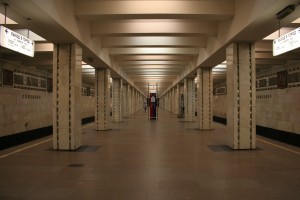The metro of Moscow was built in 1930 under Joseph Stalin rule. The project was realized in four stages. The first of the four stages was completed in 1935 when the first line, measuring 11 kilometres was open to the public. The second stage was completed in 1938 before the outbreak of WW2. The third stage was delayed, but not interrupted by the War, and two more sections were put in service. The completion of the third stage, in spite of the War, is in itself a tribute to the efficiency and capability of the Soviets. In the stations built during that period, the traditional socialist designs are replaced by war motifs. The two stations built during the third stages were inaugurated in 1943 and 1944. The fourth stage of the original plan begun after the War. The decoration and design of the last stage is arguably considered the best of all four. The construction of an even deeper section of the metro began during the Cold War era. The stations were planned to double up as shelter in the event of a nuclear war.

The Moscow Metro is no ordinary underground railway system. Stalin’s vision was to create unique stations that would double as palaces for the people of the Soviet-Union. The project was so successful that the Moscow metro is classified as historic monuments. An estimated 358000 meter square of marble was used to build sculptures, mosaics and columns that compose the decor of the miniatures underground palaces that is the Moscow metro. They depict, within the socialists limits, the great events of the ancient and modern Russian history. The realization of the magnificent project required an estimated 75000 people, mostly from the mining industry. Thousands of volunteers also participated in Stalin’s grandiose project. The metro of Moscow remains the biggest one in the world even to this day. As of 2015, the Moscow metro has 197 stations and its railway is 329 km long and mostly underground.
The initial construction was on average 40 meters deep (nowadays its deepest section is 74 meters) and offered a shelter to thousands of moscovites during the Second World War air raids. Stalins agenda of security and protection was hardly a secret when building the metro. Underneath the marble and beautiful frescos lays steel columns and concrete walls built to withstand a series of bomb attacks on Moscow. The animosity climate that reign during the 1930’s indicate the inevitability of a Nazi attack on Moscow. Stalin therefore used the metro as a passive defence mechanism thus protecting thousands of citizens. The Metro is also home to one of Russia’s greatest mysteries. If the protection agenda was known, the mystery behind “metro 2” still remain an unsolved puzzle of the Soviet Union. The station Chistye Prudy is believe to lead the way to a secret metro line laying profoundly under the city. Speculation has it that the metro line is design to be used by the officials as a head-quarter if the city ever comes under attack. The lines would connect the Kremlin, the Federal Security Services (FSB) head quarters, the ministry of defence and the airport. It is suggested that it was one of Stalin’s project in his paranoid need of security and protection. Certain documents retrieved by Washington allude to the project but its existence remains a mystery.
Confidential state secrets aside, the construction of the Moscow metro is an incredible achievement. The record time in which it was built demonstrate to the socialist sympathizer the efficiency of the Regime. Its beauty and palatial allure pay tribute to the people of Russia and their National History in a magnificent way.
www.dementieva.fr/russie/lemetro.html
A French journalist investigation of the mystery behind Metro 2.
www.youtube.com Russie Video, Découvertes des Stations du métro de Mouscou (Russia Moscow metro) T
he video takes you on a virtual tour of the Moscow metro. The narrator speaks French, but you can mute him and still enjoy the image.
All the pictures are part of the public domain and have been uploaded from www.commons.wikimedia.org


It’s interesting to integrate something with such utility, transportation, with something that is great pageantry, palaces of the people. I wonder how important it is to have the pomp of aesthetics in places that need to service large portions of the population.